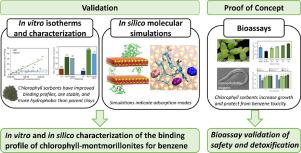Water Research ( IF 11.4 ) Pub Date : 2022-06-22 , DOI: 10.1016/j.watres.2022.118788 Kelly J Rivenbark 1 , Meichen Wang 1 , Kendall Lilly 2 , Phanourios Tamamis 3 , Timothy D Phillips 1

|
After disasters, such as forest fires and oil spills, high levels of benzene (> 1 ppm) can be detected in the water, soil, and air surrounding the disaster site, which poses a significant health risk to human, animal, and plant populations in the area. While remediation methods with activated carbons have been employed, these strategies are limited in their effectiveness due to benzene's inherent stability and limited retention to most surfaces. To address this problem, calcium and sodium montmorillonite clays were amended with a mixture of chlorophyll (a) and (b); their binding profile and ability to detoxify benzene were characterized using in vitro, in silico, and well-established ecotoxicological (ecotox) bioassay methods. The results of in vitro isothermal analyses indicated that chlorophyll-amended clays showed an improved binding profile in terms of an increased binding affinity (Kf = 668 vs 67), increased binding percentage (52% vs 11%), and decreased rates of desorption (28% vs 100%), compared to the parent clay. In silico simulation studies elucidated the adsorption mechanism and validated that the addition of the chlorophyll to the clays increased the adsorption of benzene through Van der Waals forces (i.e., aromatic π-π stacking and alkyl-π interactions). The sorbents were also assessed for their safety and ability to protect sensitive ecotox organisms (Lemna minor and Caenorhabditis elegans) from the toxicity of benzene. The inclusion of chlorophyll-amended clays in the culture medium significantly reduced benzene toxicity to both organisms, protecting C. elegans by 98–100% from benzene-induced mortality and enhancing the growth rates of L. minor. Isothermal analyses, in silico modeling, and independent bioassays all validated our proof of concept that benzene can be sequestered, tightly bound, and stabilized by chlorophyll-amended montmorillonite clays. These novel sorbents can be utilized during disasters and emergencies to decrease unintentional exposures from contaminated water, soil, and air.
中文翻译:

用于苯吸附和解毒的叶绿素改性蒙脱石粘土的开发和表征
森林火灾和石油泄漏等灾害发生后,灾区周围的水、土壤和空气中可检测到高浓度的苯(> 1 ppm),这对人类、动物和植物种群构成重大健康风险在该地区的。虽然已经采用了活性炭修复方法,但由于苯固有的稳定性和对大多数表面的有限保留,这些策略的有效性受到限制。为了解决这个问题,用叶绿素(a)和(b)的混合物对钙和钠蒙脱石粘土进行了改性;使用体外、计算机和成熟的生态毒理学(ecotox)生物测定方法对它们的结合特征和苯解毒能力进行了表征。体外等温分析结果表明,叶绿素改良粘土在结合亲和力增加(K f = 668 vs 67)、结合百分比增加(52% vs 11%)和解吸率降低方面表现出改善的结合特性(28% vs 100%),与母粘土相比。计算机模拟研究阐明了吸附机制,并验证了向粘土中添加叶绿素通过范德华力(即芳香族 π-π 堆积和烷基-π 相互作用)增加了苯的吸附。还评估了吸附剂的安全性和保护敏感生态毒素生物体(青萍和秀丽隐杆线虫)免受苯毒性的能力。培养基中添加叶绿素改良粘土显着降低了苯对两种生物体的毒性,保护线虫98-100% 免遭苯引起的死亡,并提高了小线虫的生长速度。等温分析、计算机模拟和独立生物测定都验证了我们的概念证明,即苯可以被叶绿素改性蒙脱石粘土隔离、紧密结合和稳定。这些新型吸附剂可在灾难和紧急情况下使用,以减少无意接触受污染的水、土壤和空气。











































 京公网安备 11010802027423号
京公网安备 11010802027423号